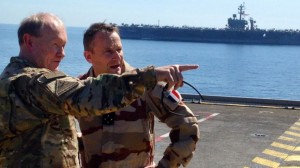
Dempsey: Some Iraqi troops show up for training ill-prepared
ABOARD THE CHARLES DE GAULLE – Some Iraqi army units in line for U.S.-led training to fight the Islamic State group are showing up ill-prepared, the top American general said Sunday.
Gen. Martin Dempsey, speaking to reporters aboard this French aircraft carrier in the northern Persian Gulf not far from Iran’s coast, said he sees no reason to send more U.S. military trainers or advisers at this time. More, broadly, he defended the pace of the overall military campaign in Iraq.
“Right now we don’t need more advisers on the ground,” Dempsey, chairman of the U.S. Joint Chiefs of Staff, said with his French counterpart, Gen. Pierre de Villiers, at his side on the hangar deck of the de Gaulle.
“We’ve got trainers and advisers that are waiting for some of the Iraqi units to show up, and when they’ve shown up — a handful of them — they’ve shown up understrength and sometimes without the proper equipment. The Iraqi government can actually fix that themselves.”
The crux of the U.S.-led coalition’s strategy for dislodging IS from Iraq is this: degrade the militants’ fighting power and resources through limited airstrikes against positions in northern and western Iraq, as well as in Syria; train and advise underperforming Iraqi security forces; and press the Iraqi government to take firmer steps to reconcile with the disaffected Sunnis.
He said the military part of the conflict could be concluded “in the foreseeable future.” The underlying problems — failures in Iraqi governance and a disaffected Sunni population — probably will take longer to resolve.
Dempsey spent the day aboard the de Gaulle to highlight U.S.-French military cooperation and to discuss strategies for combating IS in Iraq. He planned to visit Iraq next to discuss the campaign with government leaders and U.S. military commanders.
France is flying a variety of missions into Iraq from aboard the de Gaulle, which began operating in the northern Gulf on Feb. 23 and is scheduled to remain for eight weeks.
Dempsey watched as four French Rafale attack aircraft roared off the carrier’s deck en route to Iraq, and later he observed four Super Etendard fighters land after returning from a mission.
French officials said they are flying 12 to 15 missions a day, including intelligence and surveillance flights, airstrikes and close air support missions in coordination with Iraq ground troops. Dempsey said that makes the French a valued partner in a conflict that has about 20 countries flying various air missions but only three conducting maritime operations.
Dempsey arrived aboard the de Gaulle on a U.S. Navy C-2 Greyhound twin-engine aircraft. After meetings with de Villier and other French and American officers, he was catapulted off the carrier in the C-2 for a return flight to a U.S. Navy station in Bahrain. Earlier Sunday he met with Bahrain government officials.
While they met aboard the de Gaulle, an American aircraft carrier, the USS Carl Vinson, pulled to within about 1,000 yards. The two carriers have been coordinating their air operations in what Dempsey called a sign of increased U.S.-French military cooperation around the world. In an unusual arrangement, the French carrier is under the operational control of the Americans as part of the IS campaign.
Dempsey was asked by reporters to respond to criticism by some that the U.S. is not using air power aggressively enough in Iraq and Syria. Dempsey said there are valid reasons for limiting the pace of the bombing while other aspects of the conflict are addressed.
“Carpet bombing through Iraq is not the answer,” he said, adding that IS fighters have adapted since the U.S.-led bombing began in Iraqi in August.
“This is not an enemy that is sitting around in the open desert waiting for me to come find it and either use U.S. or French aircraft to attack it,” Dempsey said. “They did some of that in the beginning and paid the price. So the enemy has adapted and they have developed tactics and techniques that make them a little more difficult to find.”
Dempsey said the intensity and scale of the bombing campaign is necessarily limited by a need to avoid civilian casualties and to ensure the best possible intelligence is collected before striking targets.
“We are very precise because the very last thing we want to do is create a condition of civilian casualties on the ground, which would add to these competing narratives about taking sides and it being a religious issue, and Christianity and Islam. And so we have a responsibility to be very precise in the use of air power, and that means it takes time” to build the proper intelligence picture before striking.
“If I had more targets and I could be precise, we could produce more effects on the ground,” he added.





Leave a Reply